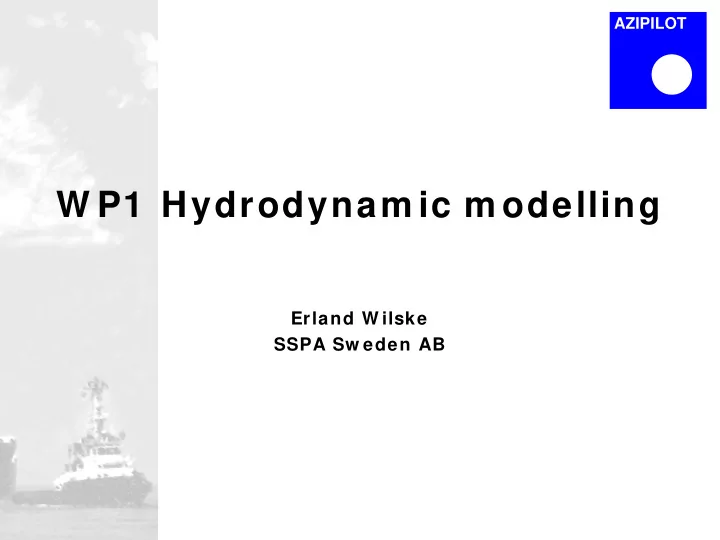

AZIPILOT W P1 Hydrodynam ic m odelling Erland W ilske SSPA Sw eden AB
AZIPILOT Content • Scope of w ork, aim s and objective • W P 1 m em bers • Groups of interest • Brief introduction to azim uth propulsion • Modelling and test m ethods • Validation m ethods and available data • Som e conclusion and identification of gaps of know ledge
AZIPILOT Aim s and objectives • Review – I dentify groups of interest – Collection and sum m ary of existing hydrodynam ic know ledge – Modelling and test m ethods – Validation m ethods and available data • Sum m arize and assim ilate ( on-going) • I m pact ( partly on-going) – Best practice for m anoeuvring m odel test procedures – Com pile engineering lectures – Map out the landscape for future R&D
AZIPILOT The WP 1 team • School of Marine Science and Technology - New castle University ( Michael W oodw ard) • Broström Aktiebolag • Cons.a.r – Italian Ship Owners Research Consortium • CTO, Ship Design and Research Centre ( Jan Kanar) • Developm ent Centre for Ship Technology and Transport System s ( Andrea Gronarz) • FORCE Technology • Foundation for Safety of Navigation and Environment Protection • Mettle ( Marielle Labrosse) • SOGREAH Consultants • South Tyneside College • SSPA Sw eden AB ( Erland W ilske) • STC - Scheepvaart en Transport College • Transas Limited • United Kingdom Maritime Pilots Association
AZIPILOT Groups of interest • Description of ACD Types (Azimuthing Control Devices) • Ship Types • Simulator Manufacturers • Simulator Facilities • Test Facilities • Shipping Companies • Pilot Organizations
AZIPILOT Types of azimuth propulsion Steerable thruster Voith Schneider Propeller Podded propulsor Schottel Pump Jet
AZIPILOT Inside a pod Air cubicle Slip ring unit Hydraulic motor Slewing bearing Internal seal • Pulling or Propeller pushing • Tandem Thrust Exciter propeller Radial bearing bearing Breaking and locking device • Contra rotating
AZIPILOT Main POD manufactures Azipod ABB Oy (AZIPOD) The consortium of a, Rolls Royce and ALSTOM (MERMAID) The consortium of SCHOTTEL GmbH & Co KG and Siemens SG Marine Solutions (SSP)
AZIPILOT Why pods? • Improved speed-power efficiency – Better hull shape – Better alignment of propeller – Less resistance from appendage • Improved manoeuvring performance Queen Mary II - 4 x 21.5 MW Mermaid pods
AZIPILOT Groups of interest – some statistics • ACD ship represent 7% of the world fleet (in number of ships) • Tugs and off-shore dominates in terms of number • Cruise ship and tankers have created a market for large ACD units (up to + 20MW)
AZIPILOT Some ship types Typical ASD tug “Dunker” operating in the Sounds Double Acting Tanker “Tempera” Twin pod Cruise vessel - Elation 8% increase in propulsion efficiency fuel savings of 40t per week compared to convensional CP prop configuration
AZIPILOT Statistics – ship with ACD
AZIPILOT ACD ships with LOA > 150 m
AZIPILOT Sources for ACD hydrodynamic modelling knowledge Major research projects • Pods-in-service (2000-2003) • Optipod (2000-2003) • Fastpod (2002-2005) • Seven other larger ACD project world wide identified
AZIPILOT Sources for ACD hydrodynamic modelling knowledge Published knowledge • ITTC - The Specialist Committee on Azimuthing Podded Propulsion • Conference series – some important – T-Pod – MARSIM – Dynamic Positioning conferences • Overview of literature comprising 90 paper (manoeuvring, Propulsive, operational and marine engineering)
AZIPILOT Hydrodynamic issues • Speed-power prediction • Prediction of structural load • Manoeuvring prediction
AZIPILOT Some preliminary conclusion Speed power prediction • Some difference among the test institutes for procedure • Some concerns about precision in speed-power prediction • Gap-effects • Harmonisation to ITTC test procedure
AZIPILOT Manouvering issues • Course stability – Needs to be carefully stuied in the design – How should IMO manoeuvring criteria apply to ACD ships? • Large heel angle • Modelling of confined water effects • Stopping procedure – Many options – Restriction due to structural loads
AZIPILOT Model testing of roll angle 7 5 6 0 5 -5 δ (deg) . 4 θ (deg) . -10 3 -15 Helm angle, 2 Roll angle, Roll angle 1 Helm angle -20 0 -25 -1 -30 -2 -35 -3 -4 -40 0 10 20 30 40 50 time, t (s)
AZIPILOT Some preliminary conclusion Structural loads • Indication that structural load is problems • Spike load when turning • Gyroscopic effect can be double the torque on the propeller axis. • Slamming on the stern
AZIPILOT Spike load during steering 200 180 160 Y p (N) . 140 Unit-control force, 120 Model test 100 Simulation 80 60 40 20 0 0 10 20 30 40 50 60 time, t (s)
Recommend
More recommend